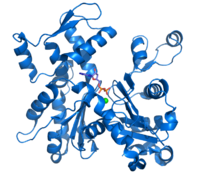
Photo from wikipedia
Actin filaments help in maintaining the cell structure and coordinating cellular movements and cargo transport within the cell. Actin participates in the interaction with several proteins and also with itself… Click to show full abstract
Actin filaments help in maintaining the cell structure and coordinating cellular movements and cargo transport within the cell. Actin participates in the interaction with several proteins and also with itself to form the helical filamentous actin (F-actin). Actin-binding proteins (ABPs) and actin-associated proteins (AAPs) coordinate the actin filament assembly and processing, regulate the flux between globular G-actin and F-actin in the cell, and help maintain the cellular structure and integrity. We have used protein–protein interaction data available through multiple sources (STRING, BioGRID, mentha, and a few others), functional annotation, and classical actin-binding domains to identify actin-binding and actin-associated proteins in the human proteome. Here, we report 2482 AAPs and present an analysis of their structural and sequential domains, functions, evolutionary conservation, cellular localization, abundance, and tissue-specific expression patterns. This analysis provides a base for the characterization of proteins involved in actin dynamics and turnover in the cell.
Journal Title: Frontiers in Cell and Developmental Biology
Year Published: 2023
Link to full text (if available)
Share on Social Media: Sign Up to like & get
recommendations!